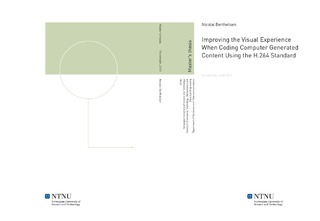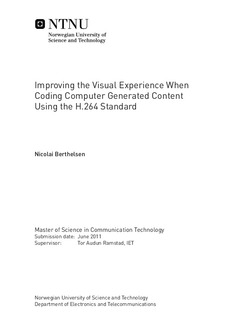| dc.contributor.advisor | Ramstad, Tor Audun | nb_NO |
| dc.contributor.author | Berthelsen, Nicolai | nb_NO |
| dc.date.accessioned | 2014-12-19T14:14:23Z | |
| dc.date.available | 2014-12-19T14:14:23Z | |
| dc.date.created | 2011-10-06 | nb_NO |
| dc.date.issued | 2011 | nb_NO |
| dc.identifier | 446122 | nb_NO |
| dc.identifier | ntnudaim:6284 | nb_NO |
| dc.identifier.uri | http://hdl.handle.net/11250/262507 | |
| dc.description.abstract | The purpose of this Master thesis was to improve the visual experience when coding computer generated content (CGC) using the H.264 standard. As H.264 is designed primarily to code natural video, it exhibits weaknesses when coding CGC at low bit rates. The thesis has focused on identifying and modifying the components in the H.264 algorithm responsible for the occurrence of unwanted noise artifacts. The research method was based on performing quantitative research to confirm or deny the hypothesis claiming that the H.264 algorithm performs sub-optimally when coding CGC. Experiments were conducted using coders written specically for the thesis. The results from these experiments were then analyzed, and conclusions were drawn based on empirical observations. An implementation of H.264 was used to identify the noise artifacts resulting from coding CGC at low rates. The results indicated that H.264 indeed performs sub-optimally when coding CGC. We learned that the reason for this was that the characteristics of CGC led to the signal being more compactly represented in the spatial domain than in the transform domain. We therefore proposed to omit the component transform and quantize the residual signal directly. This method, called residual scalar quantization (RSQ), was shown to outperform traditional H.264 coding for certain CGC in terms of quantified visual quality and bit rate. However, even when outperformed, the RSQ coder did not exhibit any of the noise artifacts present when coding with the traditional coder. We also introduced Rate-Distortion optimization, which allowed the coder to adaptively choose between traditional and RSQ coding, ensuring that each block is coded optimally, independent of the source content. This scheme was shown to outperform both stand-alone coders for all sample content. A quantizer with representation levels tailored specifically for the characteristics of CGC was also presented, and experiments showed that it outperformed uniform quantization when coding CGC. The results in this thesis were produced by simplified versions of the actual coders, and may not be completely accurate. However, the accumulated results indicate that RSQ may indeed outperform traditional H.264 coding for CGC. To confirm the theories that have been presented, the proposed techniques should be implemented in a full-scale implementation of H.264 and the experiments repeated. | nb_NO |
| dc.language | eng | nb_NO |
| dc.publisher | Institutt for elektronikk og telekommunikasjon | nb_NO |
| dc.subject | ntnudaim:6284 | no_NO |
| dc.subject | MTKOM kommunikasjonsteknologi | no_NO |
| dc.subject | Lyd- og bildebehandling | no_NO |
| dc.title | Improving the Visual Experience When Coding Computer Generated Content Using the H.264 Standard | nb_NO |
| dc.type | Master thesis | nb_NO |
| dc.source.pagenumber | 112 | nb_NO |
| dc.contributor.department | Norges teknisk-naturvitenskapelige universitet, Fakultet for informasjonsteknologi, matematikk og elektroteknikk, Institutt for telematikk | nb_NO |

